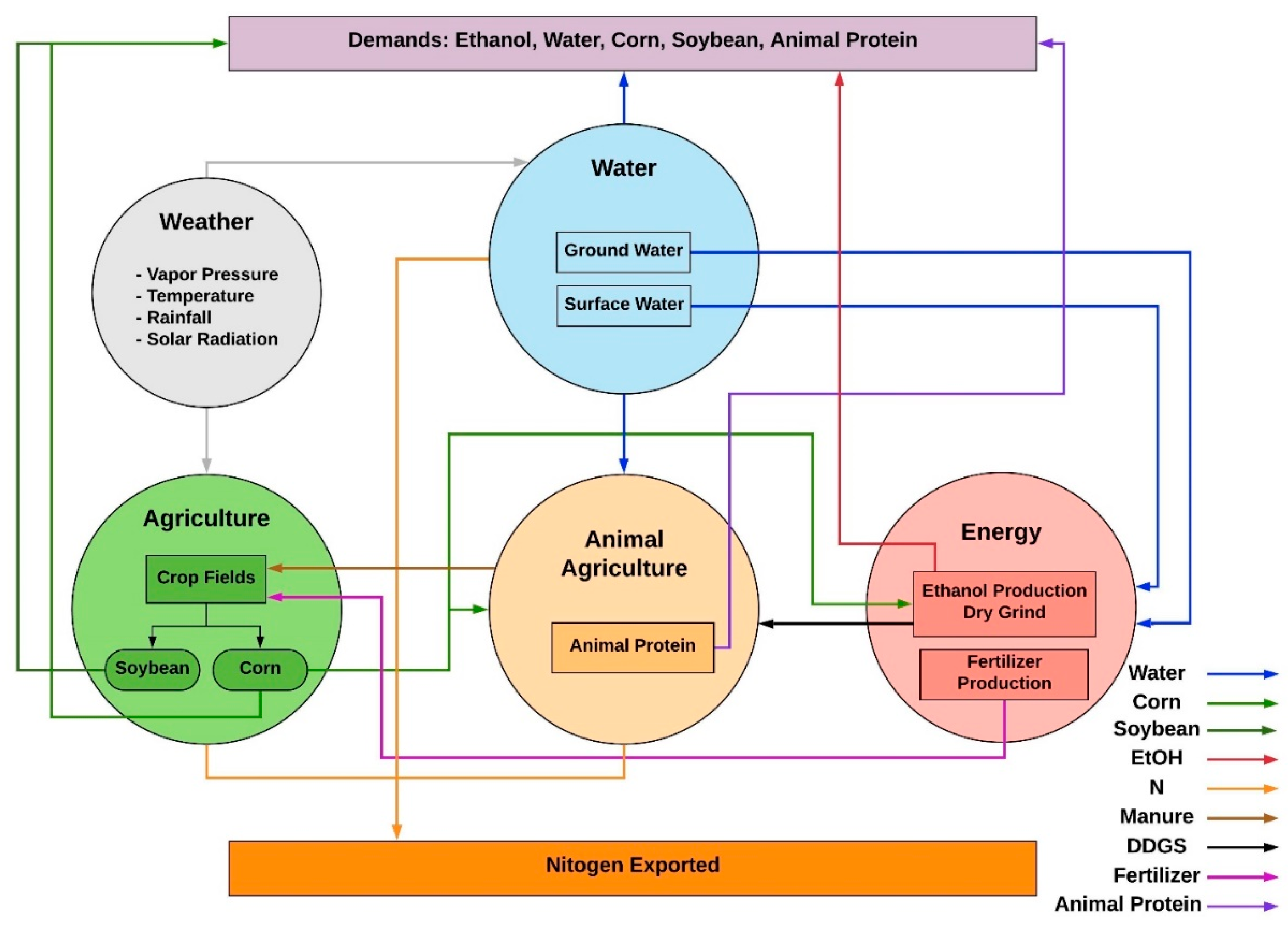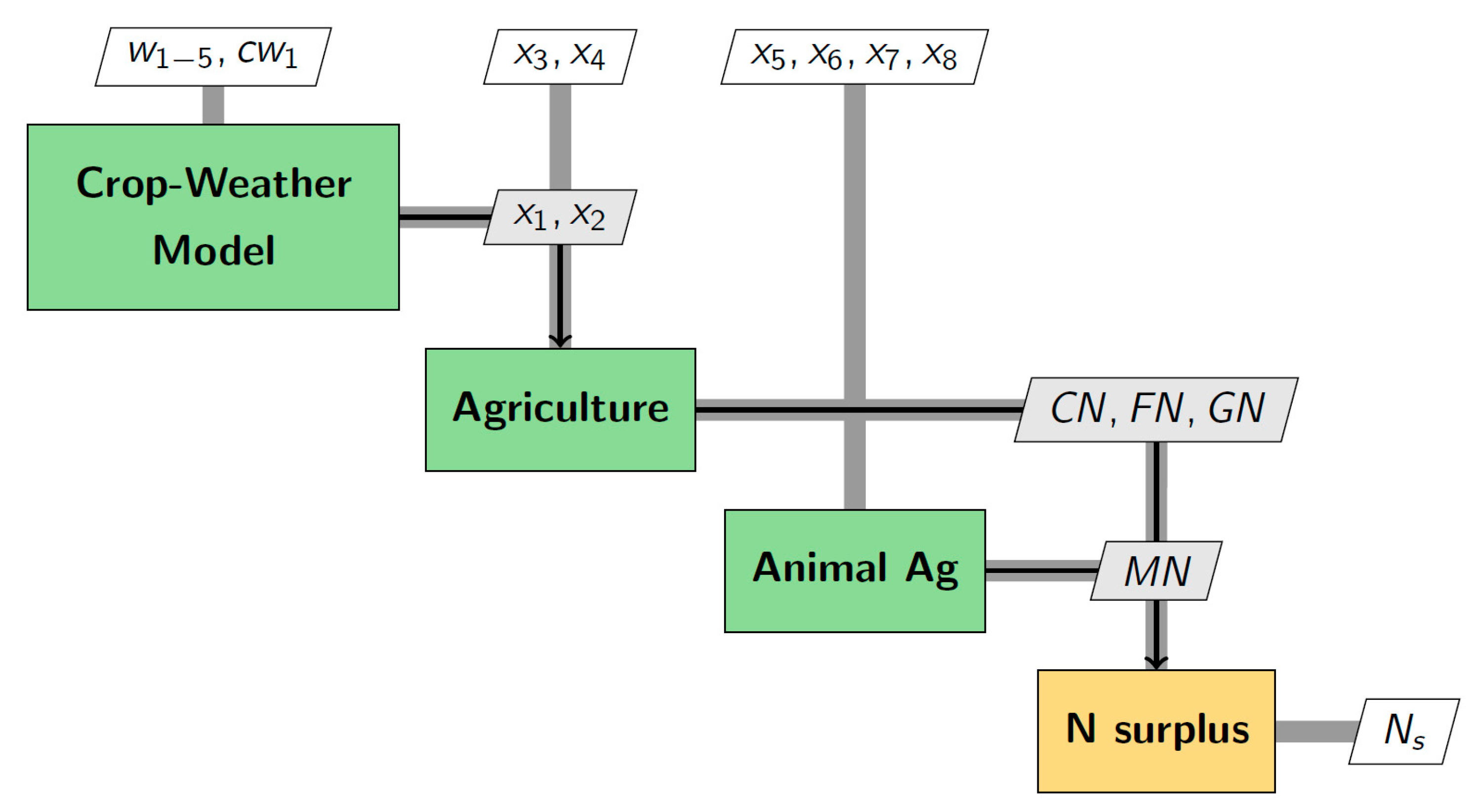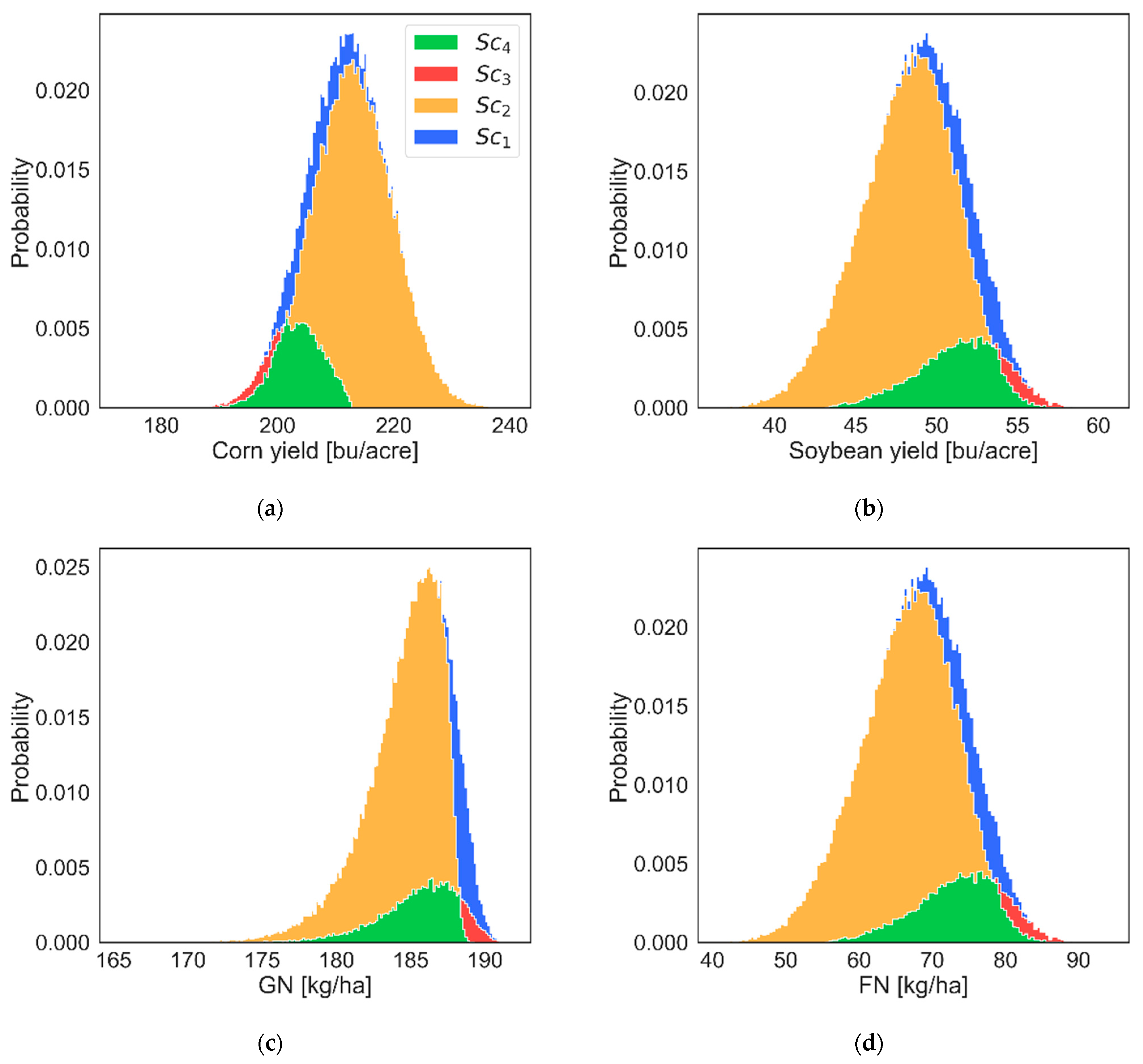Effects of Weather on Iowa Nitrogen Export Estimated by Simulation-Based Decomposition
Abstract
:1. Introduction
2. Methods
2.1. IFEW System Model Interdependencies
2.2. IFEW Macro-Level Simulation Model
2.3. Simulation Decomposition
- Identify the input parameters () and their corresponding distribution ranges in which these parameters are expected to vary. Table 2 provide input parameters and their corresponding distributions. For this example, a uniform distribution is assumed for each parameter.
- Next, for each parameter the states are identified. The states of each input parameter represent a category of outcomes (e.g., low, or high). Based on the state for each parameter, a value range is determined as seen in Table 2 for the example problem.
- Generate every possible combination of the parameter states. Each combination of states represents a unique scenario () of the to-be-decomposed simulation of the output. The number of scenarios depends on the number of states of each parameter. For the example problem, the number of scenarios is four, as shown in Table 3.
- Run the Monte Carlo simulations by randomly sampling the parameters, identifying parameter states, and evaluating output. Register output of each simulated iteration for producing full output distribution and simultaneously group the output based on the scenarios for producing decomposed sub-distribution for each scenario.
- Finally, construct appropriate output graphs or tables to better understand the cause-and-effect relationship between input and output parameters. In particular, the stacked histogram is an informative graph that displays the full output distribution and the decomposed output superimposed on full distribution. Figure 3 shows the full and decomposed distribution of the simulated output.
3. Results
4. Conclusions
Author Contributions
Funding
Institutional Review Board Statement
Informed Consent Statement
Data Availability Statement
Acknowledgments
Conflicts of Interest
References
- Diaz, R.J.; Rosenberg, R. Spreading Dead Zones and Consequences for Marine Ecosystems. Science 2008, 321, 926–929. [Google Scholar] [CrossRef] [PubMed]
- EPA. Northern Gulf of Mexico Hypoxic Zone. Available online: https://www.epa.gov/ms-htf/northern-gulf-mexico-hypoxic-zone (accessed on 2 December 2021).
- Burkart, M.R.; James, D.E. Agricultural-Nitrogen Contributions to Hypoxia in the Gulf of Mexico. J. Environ. Qual. 1999, 28, 850–859. [Google Scholar] [CrossRef]
- Jones, C.S.; Schilling, K.E. Iowa Statewide Stream Nitrate Loading: 2017–2018 Update. J. Iowa Acad. Sci. 2019, 126, 6–12. [Google Scholar] [CrossRef]
- NDEE. Ethanol Facilities’ Capacity by State. Available online: https://neo.ne.gov/programs/stats/inf/121.htm (accessed on 5 December 2021).
- Urbanchuk, J.M. Contribution of the Renewable Fuels Industry to the Economy of Iowa. Agricultural and Biofuels Consulting. Available online: https://iowarfa.org/wp-content/uploads/2020/03/2019-Iowa-Economic-Impact-Final-2.pdf (accessed on 4 December 2021).
- Bakhsh, A.; Kanwar, R.; Karlen, D. Effects of liquid swine manure applications on NO3–N leaching losses to subsurface drainage water from loamy soils in Iowa. Agric. Ecosyst. Environ. 2005, 109, 118–128. [Google Scholar] [CrossRef] [Green Version]
- Siderius, C.; Kolusu, S.R.; Todd, M.C.; Bhave, A.; Dougill, A.J.; Reason, C.J.; Mkwambisi, D.D.; Kashaigili, J.J.; Pardoe, J.; Harou, J.J.; et al. Climate variability affects water-energy-food infrastructure performance in East Africa. One Earth 2021, 4, 397–410. [Google Scholar] [CrossRef]
- Berardy, A.; Chester, M.V. Climate change vulnerability in the food, energy, and water nexus: Concerns for agricultural production in Arizona and its urban export supply. Environ. Res. Lett. 2017, 12, 035004. [Google Scholar] [CrossRef]
- Raul, V.; Leifsson, L.; Kaleita, A. System Modeling and Sensitivity Analysis of the Iowa Food-Water-Energy Nexus. J. Environ. Inform. Lett. 2020, 4, 73–79. Available online: http://www.jeiletters.org/index.php?journal=mys&page=article&op=view&path%5B%5D=202000044 (accessed on 1 August 2021). [CrossRef]
- Westcott, P.C.; Jewison, M. Weather Effects on Expected Corn and Soybean Yields; Feed Outlook No. (FDS-13G-01); USDA Economic Research Service: Washington, DC, USA, 2013. Available online: https://www.ers.usda.gov/publications/pub-details/?pubid=36652 (accessed on 23 November 2021).
- Kozlova, M.; Collan, M.; Luukka, P. Simulation decomposition: New approach for better simulation analysis of multi-variable investment projects. Fuzzy Econ. Rev. 2016, 21, 3–18. [Google Scholar] [CrossRef]
- Kozlova, M.; Yeomans, J.S. Multi-Variable Simulation Decomposition in Environmental Planning: An Application to Carbon Capture and Storage. J. Environ. Inform. Lett. 2019, 1, 20–26. [Google Scholar] [CrossRef] [Green Version]
- Lambe, A.B.; Martins, J.R.R.A. Extensions to the design structure matrix for the description of multidisciplinary design, analysis, and optimization processes. Struct. Multidiscip. Optim. 2012, 46, 273–284. [Google Scholar] [CrossRef]
- USDA. Crop Production 2019 Summary. Crop Production 2019 Summary 01/10/2020 (usda.gov) 2020. Available online: https://www.nass.usda.gov/Publications/Todays_Reports/reports/cropan20.pdf (accessed on 4 December 2021).
- Blesh, J.; Drinkwater, L.E. The impact of nitrogen source and crop rotation on nitrogen mass balances in the Mississippi River Basin. Ecol. Appl. 2013, 23, 1017–1035. [Google Scholar] [CrossRef] [PubMed]
- Barry, D.A.J.; Goorahoo, D.; Goss, M.J. Estimation of Nitrate Concentrations in Groundwater Using a Whole Farm Nitrogen Budget. J. Environ. Qual. 1993, 22, 767–775. [Google Scholar] [CrossRef]
- USDA. National Agricultural Statistics Service Quick Stats. Available online: https://quickstats.nass.usda.gov/ (accessed on 24 November 2021).
- Gronberg, J.M.; Arnold, T.L. County-Level Estimates of Nitrogen and Phosphorus from Animal Manure for the Conterminous United States, 2007 and 2012 (No. 2017-1021); US Geological Survey: Reston, VA, USA, 2017. [CrossRef] [Green Version]
- Jones, C.S.; Drake, C.W.; Hruby, C.E.; Schilling, K.E.; Wolter, C.F. Livestock manure driving stream nitrate. Ambio 2019, 48, 1143–1153. [Google Scholar] [CrossRef] [PubMed]
- Kroese, D.P.; Brereton, T.; Taimre, T.; Botev, Z.I. Why the Monte Carlo method is so important today. WIREs Comput. Stat. 2014, 6, 386–392. [Google Scholar] [CrossRef]
- Kozlova, M.; Yeomans, J.S. Monte Carlo Enhancement via Simulation Decomposition: A “Must-Have” Inclusion for Many Disciplines. INFORMS Trans. Educ. 2020. [Google Scholar] [CrossRef]
- Sawyer, J.E. Nitrogen Use in Iowa Corn Production; Crop 3073; Iowa State University Extention and Outreach: Ames, IA, USA. Available online: https://store.extension.iastate.edu/Product/Nitrogen-Use-in-Iowa-Corn-Production (accessed on 20 November 2021).
- USDA. Fertilizer Use and Price. Available online: https://www.ers.usda.gov/data-products/fertilizer-use-and-price/ (accessed on 29 November 2021).
- McKay, M.D.; Beckman, R.J.; Conover, W. A comparison of three methods for selecting values of input variables in the analysis of output from a computer code. Technometrics 2000, 42, 55–61. [Google Scholar] [CrossRef]






| Livestock Group | Nitrogen in Manure (AMN) (kg per Animal per Day) | Life Cycle (LF) (Days per Year) |
|---|---|---|
| Hog/pigs | 0.027 | 365 |
| Beef cattle | 0.15 | 365 |
| Milk cows | 0.204 | 365 |
| Heifer/steers (0.5 × other cattle) | 0.1455 | 365 |
| Slaughter cattle (0.5 × other cattle) | 0.104 | 170 |
| Parameter | Distribution/Range | State | Boundary |
|---|---|---|---|
| U [0, 10] | Low | [0–5) | |
| High | (5–10] | ||
| U [0, 10] | Low | [0–5) | |
| High | (5–10] |
| Scenario | Combination of States |
|---|---|
| Sc1 | : Low |
| Sc2 | : High |
| Sc3 | : Low |
| Sc4 | : Low |
| Parameter | Distribution/Range | State | Boundary |
|---|---|---|---|
| July temperature (w1) | N [2, 74] | Regular | ≤76 °F |
| High | >76 °F | ||
| July precipitation (w2) | LogN [0.4, 0, 4] | Regular | ≥2.5 in |
| Low | <2.5 in |
| Scenario | Combination of States | Description |
|---|---|---|
| Sc1 | w1: Regular, w2: Low | Regular-T Low-PPT |
| Sc2 | w1: Regular, w2: Regular | Regular condition |
| Sc3 | w1: High, w2: Low | Dry condition |
| Sc4 | w1: High, w2: Regular | High-T Regular-PPT |
Publisher’s Note: MDPI stays neutral with regard to jurisdictional claims in published maps and institutional affiliations. |
© 2022 by the authors. Licensee MDPI, Basel, Switzerland. This article is an open access article distributed under the terms and conditions of the Creative Commons Attribution (CC BY) license (https://creativecommons.org/licenses/by/4.0/).
Share and Cite
Raul, V.; Liu, Y.-C.; Leifsson, L.; Kaleita, A. Effects of Weather on Iowa Nitrogen Export Estimated by Simulation-Based Decomposition. Sustainability 2022, 14, 1060. https://doi.org/10.3390/su14031060
Raul V, Liu Y-C, Leifsson L, Kaleita A. Effects of Weather on Iowa Nitrogen Export Estimated by Simulation-Based Decomposition. Sustainability. 2022; 14(3):1060. https://doi.org/10.3390/su14031060
Chicago/Turabian StyleRaul, Vishal, Yen-Chen Liu, Leifur Leifsson, and Amy Kaleita. 2022. "Effects of Weather on Iowa Nitrogen Export Estimated by Simulation-Based Decomposition" Sustainability 14, no. 3: 1060. https://doi.org/10.3390/su14031060
APA StyleRaul, V., Liu, Y.-C., Leifsson, L., & Kaleita, A. (2022). Effects of Weather on Iowa Nitrogen Export Estimated by Simulation-Based Decomposition. Sustainability, 14(3), 1060. https://doi.org/10.3390/su14031060





